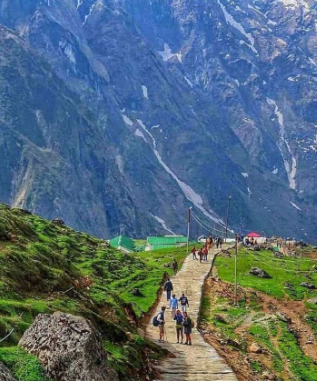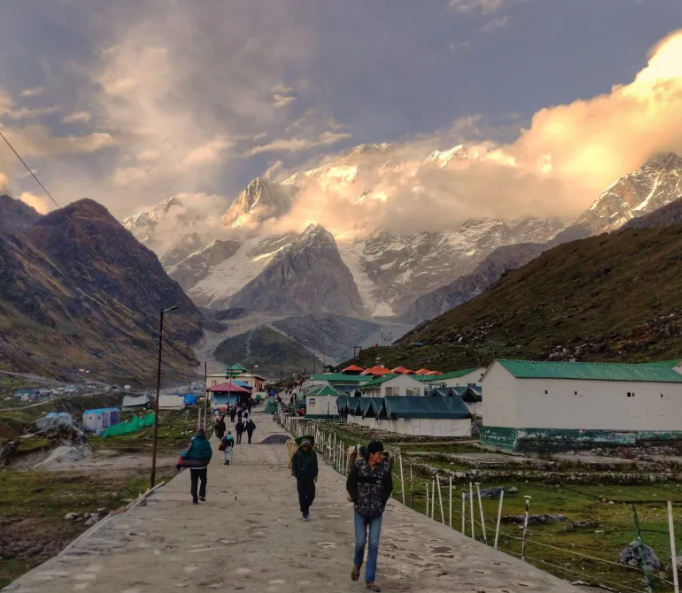Discover the magical Kedarnath Temple, a site of heavenly tranquility and profound spiritual meaning. See this extensive guide to know about its tales, rich history, and more.
Famous for its profound spiritual significance and breathtaking natural beauty, Kedarnath Temple is a revered Hindu pilgrimage site nestled in the beautiful Himalayas. The rich history, stunning architecture, and distinctive spiritual experience that this temple provides will all be covered in this article. Along with the efforts to protect this holy spot, we will talk about the yearly Char Dham Yatra.
Table of Contents
- Historical Significance of Kedarnath Temple
- Architecture and Design
- Spiritual Significance
- The Kedarnath Trek
- The Char Dham Yatra
- Kedarnath Temple’s Role in Indian Culture
- Accommodation Options
- Conclusion
- Frequently Asked Questions
1) Historical Significance of Kedarnath Temple
Kedarnath Temple is believed to have been constructed during the 8th century by the revered Hindu philosopher and theologian, Adi Shankaracharya. He is credited with establishing the four major pilgrimage sites, or Char Dham, in the Indian Himalayas, and Kedarnath is one of these char dhams.
Kedarnath is part of the Chota Char Dham, which is a smaller circuit of pilgrimage sites in Uttarakhand. It holds a special place in the hearts of Hindus and is visited by thousands of devotees and pilgrims annually.
The temple’s significance is rooted in Hindu mythology. According to the Mahabharata, after the Kurukshetra War, the Pandavas sought forgiveness from Lord Shiva for their sins during the battle. Lord Shiva took the form of a bull and submerged himself at Kedarnath, later reappearing in the form of a natural rock formation, which is now worshipped as the deity in the temple.
2) Architecture and Design
In the Garhwal Himalayas, Kedarnath Temple is located at a height of roughly 3,583 meters (11,755 feet) above sea level. Its spiritual significance is increased by its setting amidst the Himalayas’ amazing natural beauty.
The temple is designed in the Nagara style, which is typical of northern India’s temple architecture. The towering spire, or shikhara, that tapers to a point, is a distinguishing feature of this architectural style. Stone carvings adorn the shikhara of Kedarnath Temple.
Large stone slabs and blocks are usually used in the construction of the temple. The complex carvings on these stones provide a temple that is both aesthetically pleasing and sound structurally.
A conical or pyramidal shape characterizes the main temple construction, which is compact and relatively simple. Withstanding the severe weather of the Himalayas, especially prolonged snowfall, is the main goal of the design.
Shiva Lingam, the symbol of Lord Shiva, is kept in the inner sanctuary, or garbhagriha. Here, devotees present the god with their prayers and gifts. Part of the temple most sacrosanct, the sanctum is a darkly illuminated chamber.
In front of the sanctuary is a large assembly hall called a mandap. For rituals and prayers, devotees congregate here. With a beautiful ceiling, the mandap is supported by elaborate pillars.
The exterior walls of the temple are adorned with intricate stone carvings that depict an array of deities, themes, and sacred symbols. These sculptures serve as examples of the artists’ skill from that era.
At the entrance to the temple, exquisitely crafted wooden doors adorned with figures and patterns accentuate its grandeur.
The serene and breathtaking environment where the temple is situated is dwarfed by the majestic Kedarnath Peak. Both the surrounding natural surroundings and the architecture of the temple create a very spiritual mood.
Due to its high altitude and the severe local weather, the temple is only accessible during the summer. In the lengthy winter months, it is constantly closed.
The Kedarnath Temple’s architecture and design are a testament to the cultural and religious heritage of India. The temple’s enduring presence in the Himalayas continues to draw countless pilgrims and visitors who seek spiritual solace in this sacred place.
3) Spiritual Significance
Kedarnath Temple is not just a physical structure; it’s a spiritual haven for countless devotees. Many believe that a visit to Kedarnath can cleanse the soul and wash away one’s sins. Pilgrims come from all corners of India and the world to seek blessings and experience the divine presence of Lord Shiva.
It is believed that by visiting Kedarnath and undertaking the rigorous pilgrimage, devotees can seek spiritual awakening and work towards attaining moksha, which is liberation from the cycle of birth and death.
The temple is the site of various rituals and festivals, with the most significant one being the Kedarnath Temple opening and closing ceremonies that mark the beginning and end of the pilgrimage season. These events are grand celebrations with traditional music, dance, and religious ceremonies.
Kedarnath Temple is a place of deep spirituality and a symbol of unwavering faith for many Hindus. Pilgrims visit not only for the divine connection but also to experience the serenity of the Himalayas and the spiritual energy that permeates the region. The temple’s remote location and the natural beauty of the surroundings contribute to its spiritual significance, making it a place of profound religious devotion and introspection.
4) The Kedarnath Trek
Location: The trek starts from Gaurikund, a small town in the Rudraprayag district of Uttarakhand.
Distance: The trek covers a distance of approximately 16 kilometers (10 miles) one way.
Altitude: The trek gains a significant altitude, with Kedarnath Temple situated at an elevation of around 3,583 meters (11,755 feet) above sea level.
Terrain: The trail takes you through a mix of steep ascents, rocky paths, and scenic meadows. It is surrounded by the stunning beauty of the Garhwal Himalayas.
Duration: The time it takes to complete the trek can vary depending on your pace and the weather conditions. It typically takes 6-8 hours to reach the Kedarnath Temple from Gaurikund.
Best Time to Visit: The ideal time for the trek is during the summer months (May to June) and early autumn (September to October). The temple is closed during the harsh winter due to heavy snowfall.
Accommodation: There are various guesthouses and tents available along the trek route for pilgrims and trekkers to rest and spend the night.
Preparation: Trekkers and pilgrims should be physically fit and prepared for the high-altitude trek. It’s important to check weather conditions, carry appropriate clothing, and be aware of altitude-related health risks.
5) The Char Dham Yatra
The Char Dham Yatra is traditionally completed in a specific order, usually starting with Yamunotri, followed by Gangotri, Kedarnath, and concluding with a visit to Badrinath. Pilgrims embark on this journey to seek spiritual enlightenment, cleanse their souls, and attain salvation. The yatra typically takes place during the summer months when these remote temple sites are accessible, and the weather is more favorable. It’s a sacred and challenging journey, and pilgrims often face rugged terrain, extreme weather conditions, and high altitudes during their trek.
6) Kedarnath Temple’s Role in Indian Culture
The Kedarnath Temple holds a significant and revered place in Indian culture and spirituality. It is one of the holiest Hindu temples and is dedicated to Lord Shiva, one of the principal deities in the Hindu pantheon. The temple is located in the Garhwal region of the Indian state of Uttarakhand, amidst the breathtaking Himalayan mountains.
Kedarnath’s location in the Himalayas contributes to its significance in Indian culture. The temple is surrounded by breathtaking natural beauty, including snow-capped peaks, pristine rivers, and lush green valleys. It is seen as a place where devotees can connect with both the divine and the natural world.
7) Accommodation Options
For pilgrims visiting Kedarnath, various accommodation options are available. From budget lodges to more comfortable guesthouses, there are choices to suit every traveler’s needs. It’s essential to plan your stay in advance, especially during peak pilgrimage seasons. Here are some accommodation options in and around Kedarnath:
GMVN Tourist Rest House: The Garhwal Mandal Vikas Nigam (GMVN) operates several budget-friendly tourist rest houses in Kedarnath. These are basic accommodations but provide a comfortable stay for pilgrims.
Private Guesthouses and Lodges: There are various privately-run guesthouses and lodges in Kedarnath town that offer a range of rooms to suit different budgets.
Tents and Camps: During the peak pilgrimage season, temporary tented accommodations are set up to accommodate a large number of visitors. These camps provide basic facilities and are often the only option for some pilgrims.
Dharamshalas: There are dharamshalas (charitable guesthouses) in and around Kedarnath that provide very basic accommodation at a low cost. These are often used by religious pilgrims.
Homestays: In recent years, some local residents have started offering homestays to tourists. This can be a great way to experience the local culture and hospitality.
8) Conclusion
Kedarnath Temple stands as a testament to India’s spiritual and architectural heritage. It’s a place where nature and divinity come together to create a unique and awe-inspiring experience. Whether you seek spiritual enlightenment or simply wish to explore the beauty of the Himalayas, Kedarnath offers an unforgettable journey.
9) FAQs
1. Is Kedarnath Temple open throughout the year?
- No, Kedarnath Temple is open only for six months, from April to November, due to extreme weather conditions during the winter.
2. What is the best time to visit Kedarnath?
- The best time to visit Kedarnath is during the summer months, from May to June and September to November, when the weather is relatively pleasant.
3. Can I reach Kedarnath by road?
- Yes, you can reach Gaurikund by road, and from there, you can trek to Kedarnath. Helicopter services are also available for a quicker journey.
4. Are there medical facilities available in Kedarnath?
- Yes, there are basic medical facilities available in Kedarnath, but it’s advisable to carry essential medications and a first-aid kit.
5. How long is the trek to Kedarnath Temple?
- The trek to Kedarnath Temple is approximately 16 kilometers, and it takes about 6-8 hours to complete on foot.
To Know more about Indian tourist places then click on given below link https://travellingfest.com/category/indian-destination/








